Xiaohe Wu
SelfHVD: Self-Supervised Handheld Video Deblurring for Mobile Phones
Aug 12, 2025Abstract:Shooting video with a handheld mobile phone, the most common photographic device, often results in blurry frames due to shaking hands and other instability factors. Although previous video deblurring methods have achieved impressive progress, they still struggle to perform satisfactorily on real-world handheld video due to the blur domain gap between training and testing data. To address the issue, we propose a self-supervised method for handheld video deblurring, which is driven by sharp clues in the video. First, to train the deblurring model, we extract the sharp clues from the video and take them as misalignment labels of neighboring blurry frames. Second, to improve the model's ability, we propose a novel Self-Enhanced Video Deblurring (SEVD) method to create higher-quality paired video data. Third, we propose a Self-Constrained Spatial Consistency Maintenance (SCSCM) method to regularize the model, preventing position shifts between the output and input frames. Moreover, we construct a synthetic and a real-world handheld video dataset for handheld video deblurring. Extensive experiments on these two and other common real-world datasets demonstrate that our method significantly outperforms existing self-supervised ones. The code and datasets are publicly available at https://github.com/cshonglei/SelfHVD.
Image Demoiréing Using Dual Camera Fusion on Mobile Phones
Jun 10, 2025Abstract:When shooting electronic screens, moir\'e patterns usually appear in captured images, which seriously affects the image quality. Existing image demoir\'eing methods face great challenges in removing large and heavy moir\'e. To address the issue, we propose to utilize Dual Camera fusion for Image Demoir\'eing (DCID), \ie, using the ultra-wide-angle (UW) image to assist the moir\'e removal of wide-angle (W) image. This is inspired by two motivations: (1) the two lenses are commonly equipped with modern smartphones, (2) the UW image generally can provide normal colors and textures when moir\'e exists in the W image mainly due to their different focal lengths. In particular, we propose an efficient DCID method, where a lightweight UW image encoder is integrated into an existing demoir\'eing network and a fast two-stage image alignment manner is present. Moreover, we construct a large-scale real-world dataset with diverse mobile phones and monitors, containing about 9,000 samples. Experiments on the dataset show our method performs better than state-of-the-art methods. Code and dataset are available at https://github.com/Mrduckk/DCID.
Pseudo-Label Guided Real-World Image De-weathering: A Learning Framework with Imperfect Supervision
Apr 14, 2025

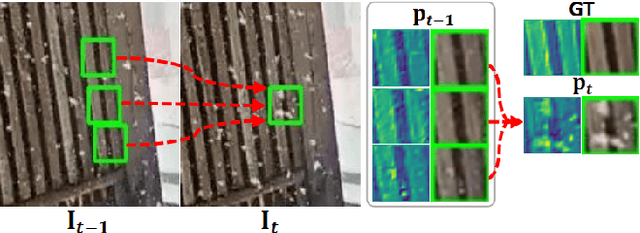
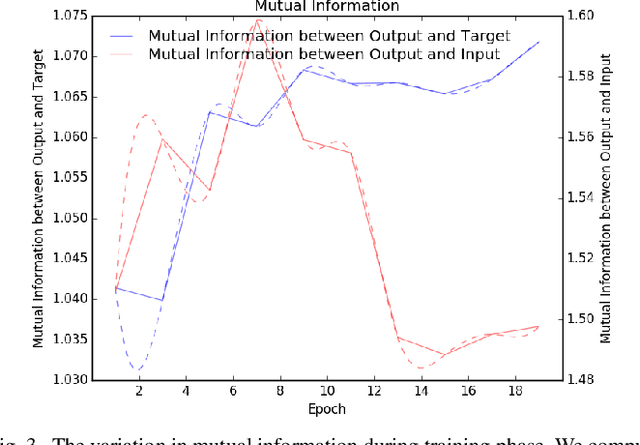
Abstract:Real-world image de-weathering aims at removingvarious undesirable weather-related artifacts, e.g., rain, snow,and fog. To this end, acquiring ideal training pairs is crucial.Existing real-world datasets are typically constructed paired databy extracting clean and degraded images from live streamsof landscape scene on the Internet. Despite the use of strictfiltering mechanisms during collection, training pairs inevitablyencounter inconsistency in terms of lighting, object position, scenedetails, etc, making de-weathering models possibly suffer fromdeformation artifacts under non-ideal supervision. In this work,we propose a unified solution for real-world image de-weatheringwith non-ideal supervision, i.e., a pseudo-label guided learningframework, to address various inconsistencies within the realworld paired dataset. Generally, it consists of a de-weatheringmodel (De-W) and a Consistent Label Constructor (CLC), bywhich restoration result can be adaptively supervised by originalground-truth image to recover sharp textures while maintainingconsistency with the degraded inputs in non-weather contentthrough the supervision of pseudo-labels. Particularly, a Crossframe Similarity Aggregation (CSA) module is deployed withinCLC to enhance the quality of pseudo-labels by exploring thepotential complementary information of multi-frames throughgraph model. Moreover, we introduce an Information AllocationStrategy (IAS) to integrate the original ground-truth imagesand pseudo-labels, thereby facilitating the joint supervision forthe training of de-weathering model. Extensive experimentsdemonstrate that our method exhibits significant advantageswhen trained on imperfectly aligned de-weathering datasets incomparison with other approaches.
DeblurDiff: Real-World Image Deblurring with Generative Diffusion Models
Feb 06, 2025



Abstract:Diffusion models have achieved significant progress in image generation. The pre-trained Stable Diffusion (SD) models are helpful for image deblurring by providing clear image priors. However, directly using a blurry image or pre-deblurred one as a conditional control for SD will either hinder accurate structure extraction or make the results overly dependent on the deblurring network. In this work, we propose a Latent Kernel Prediction Network (LKPN) to achieve robust real-world image deblurring. Specifically, we co-train the LKPN in latent space with conditional diffusion. The LKPN learns a spatially variant kernel to guide the restoration of sharp images in the latent space. By applying element-wise adaptive convolution (EAC), the learned kernel is utilized to adaptively process the input feature, effectively preserving the structural information of the input. This process thereby more effectively guides the generative process of Stable Diffusion (SD), enhancing both the deblurring efficacy and the quality of detail reconstruction. Moreover, the results at each diffusion step are utilized to iteratively estimate the kernels in LKPN to better restore the sharp latent by EAC. This iterative refinement enhances the accuracy and robustness of the deblurring process. Extensive experimental results demonstrate that the proposed method outperforms state-of-the-art image deblurring methods on both benchmark and real-world images.
Generative Inbetweening through Frame-wise Conditions-Driven Video Generation
Dec 16, 2024



Abstract:Generative inbetweening aims to generate intermediate frame sequences by utilizing two key frames as input. Although remarkable progress has been made in video generation models, generative inbetweening still faces challenges in maintaining temporal stability due to the ambiguous interpolation path between two key frames. This issue becomes particularly severe when there is a large motion gap between input frames. In this paper, we propose a straightforward yet highly effective Frame-wise Conditions-driven Video Generation (FCVG) method that significantly enhances the temporal stability of interpolated video frames. Specifically, our FCVG provides an explicit condition for each frame, making it much easier to identify the interpolation path between two input frames and thus ensuring temporally stable production of visually plausible video frames. To achieve this, we suggest extracting matched lines from two input frames that can then be easily interpolated frame by frame, serving as frame-wise conditions seamlessly integrated into existing video generation models. In extensive evaluations covering diverse scenarios such as natural landscapes, complex human poses, camera movements and animations, existing methods often exhibit incoherent transitions across frames. In contrast, our FCVG demonstrates the capability to generate temporally stable videos using both linear and non-linear interpolation curves. Our project page and code are available at \url{https://fcvg-inbetween.github.io/}.
Seeing Beyond Views: Multi-View Driving Scene Video Generation with Holistic Attention
Dec 04, 2024Abstract:Generating multi-view videos for autonomous driving training has recently gained much attention, with the challenge of addressing both cross-view and cross-frame consistency. Existing methods typically apply decoupled attention mechanisms for spatial, temporal, and view dimensions. However, these approaches often struggle to maintain consistency across dimensions, particularly when handling fast-moving objects that appear at different times and viewpoints. In this paper, we present CogDriving, a novel network designed for synthesizing high-quality multi-view driving videos. CogDriving leverages a Diffusion Transformer architecture with holistic-4D attention modules, enabling simultaneous associations across the spatial, temporal, and viewpoint dimensions. We also propose a lightweight controller tailored for CogDriving, i.e., Micro-Controller, which uses only 1.1% of the parameters of the standard ControlNet, enabling precise control over Bird's-Eye-View layouts. To enhance the generation of object instances crucial for autonomous driving, we propose a re-weighted learning objective, dynamically adjusting the learning weights for object instances during training. CogDriving demonstrates strong performance on the nuScenes validation set, achieving an FVD score of 37.8, highlighting its ability to generate realistic driving videos. The project can be found at https://luhannan.github.io/CogDrivingPage/.
Reblurring-Guided Single Image Defocus Deblurring: A Learning Framework with Misaligned Training Pairs
Sep 26, 2024
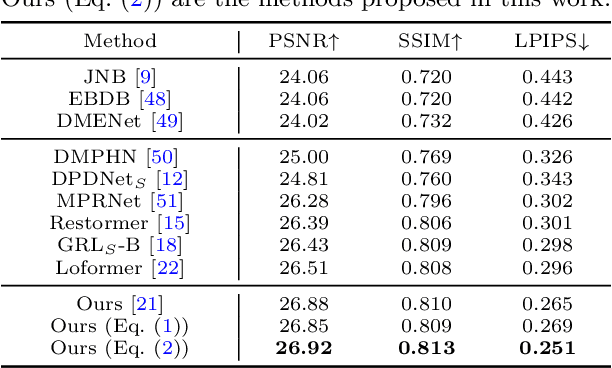
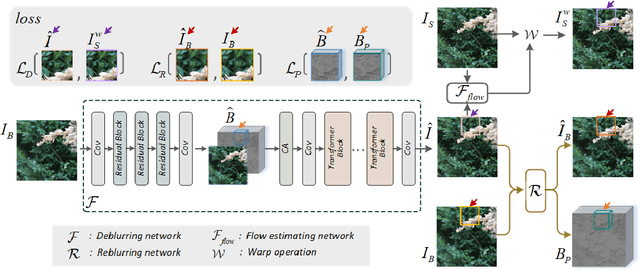
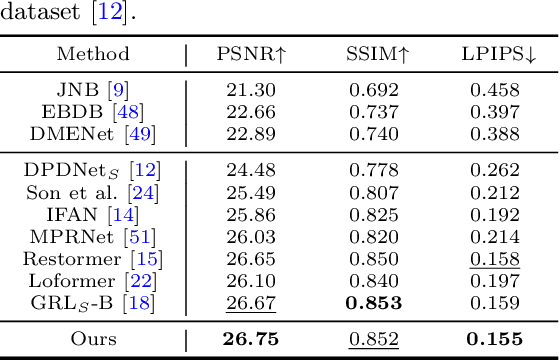
Abstract:For single image defocus deblurring, acquiring well-aligned training pairs (or training triplets), i.e., a defocus blurry image, an all-in-focus sharp image (and a defocus blur map), is an intricate task for the development of deblurring models. Existing image defocus deblurring methods typically rely on training data collected by specialized imaging equipment, presupposing that these pairs or triplets are perfectly aligned. However, in practical scenarios involving the collection of real-world data, direct acquisition of training triplets is infeasible, and training pairs inevitably encounter spatial misalignment issues. In this work, we introduce a reblurring-guided learning framework for single image defocus deblurring, enabling the learning of a deblurring network even with misaligned training pairs. Specifically, we first propose a baseline defocus deblurring network that utilizes spatially varying defocus blur map as degradation prior to enhance the deblurring performance. Then, to effectively learn the baseline defocus deblurring network with misaligned training pairs, our reblurring module ensures spatial consistency between the deblurred image, the reblurred image and the input blurry image by reconstructing spatially variant isotropic blur kernels. Moreover, the spatially variant blur derived from the reblurring module can serve as pseudo supervision for defocus blur map during training, interestingly transforming training pairs into training triplets. Additionally, we have collected a new dataset specifically for single image defocus deblurring (SDD) with typical misalignments, which not only substantiates our proposed method but also serves as a benchmark for future research.
MC$^2$: Multi-concept Guidance for Customized Multi-concept Generation
Apr 12, 2024Abstract:Customized text-to-image generation aims to synthesize instantiations of user-specified concepts and has achieved unprecedented progress in handling individual concept. However, when extending to multiple customized concepts, existing methods exhibit limitations in terms of flexibility and fidelity, only accommodating the combination of limited types of models and potentially resulting in a mix of characteristics from different concepts. In this paper, we introduce the Multi-concept guidance for Multi-concept customization, termed MC$^2$, for improved flexibility and fidelity. MC$^2$ decouples the requirements for model architecture via inference time optimization, allowing the integration of various heterogeneous single-concept customized models. It adaptively refines the attention weights between visual and textual tokens, directing image regions to focus on their associated words while diminishing the impact of irrelevant ones. Extensive experiments demonstrate that MC$^2$ even surpasses previous methods that require additional training in terms of consistency with input prompt and reference images. Moreover, MC$^2$ can be extended to elevate the compositional capabilities of text-to-image generation, yielding appealing results. Code will be publicly available at https://github.com/JIANGJiaXiu/MC-2.
Learning with Noisy Labels Using Collaborative Sample Selection and Contrastive Semi-Supervised Learning
Oct 24, 2023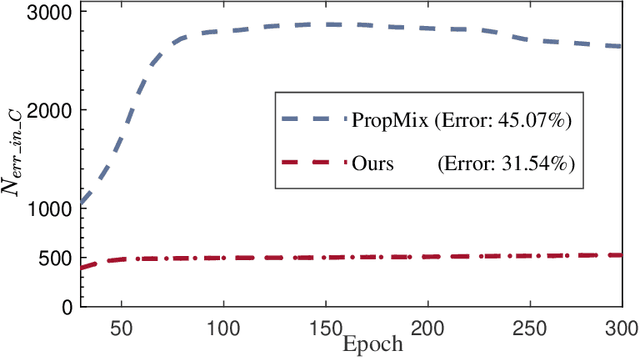
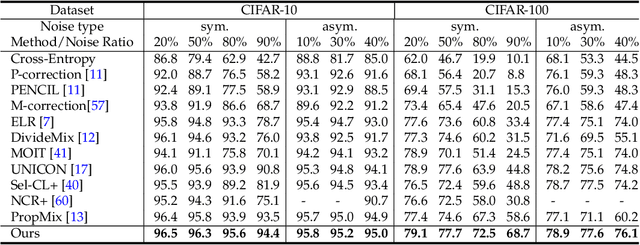
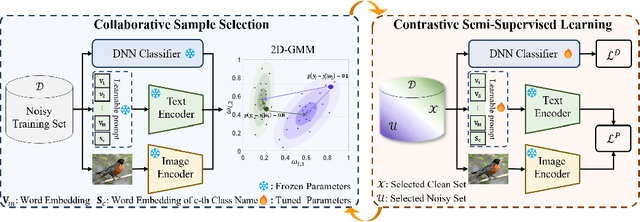
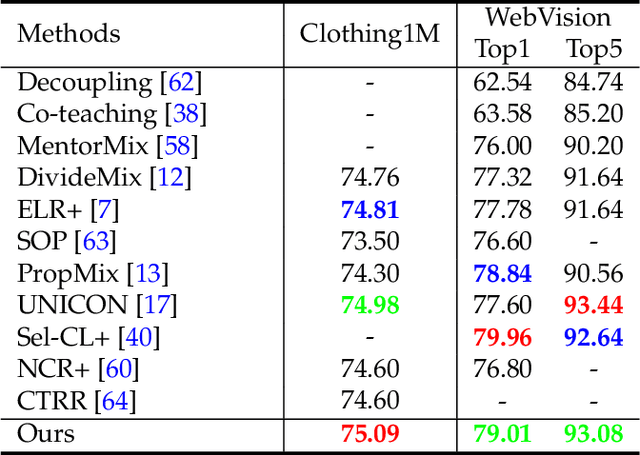
Abstract:Learning with noisy labels (LNL) has been extensively studied, with existing approaches typically following a framework that alternates between clean sample selection and semi-supervised learning (SSL). However, this approach has a limitation: the clean set selected by the Deep Neural Network (DNN) classifier, trained through self-training, inevitably contains noisy samples. This mixture of clean and noisy samples leads to misguidance in DNN training during SSL, resulting in impaired generalization performance due to confirmation bias caused by error accumulation in sample selection. To address this issue, we propose a method called Collaborative Sample Selection (CSS), which leverages the large-scale pre-trained model CLIP. CSS aims to remove the mixed noisy samples from the identified clean set. We achieve this by training a 2-Dimensional Gaussian Mixture Model (2D-GMM) that combines the probabilities from CLIP with the predictions from the DNN classifier. To further enhance the adaptation of CLIP to LNL, we introduce a co-training mechanism with a contrastive loss in semi-supervised learning. This allows us to jointly train the prompt of CLIP and the DNN classifier, resulting in improved feature representation, boosted classification performance of DNNs, and reciprocal benefits to our Collaborative Sample Selection. By incorporating auxiliary information from CLIP and utilizing prompt fine-tuning, we effectively eliminate noisy samples from the clean set and mitigate confirmation bias during training. Experimental results on multiple benchmark datasets demonstrate the effectiveness of our proposed method in comparison with the state-of-the-art approaches.
Learning Real-World Image De-Weathering with Imperfect Supervision
Oct 23, 2023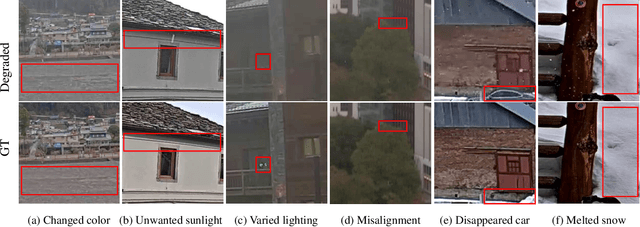

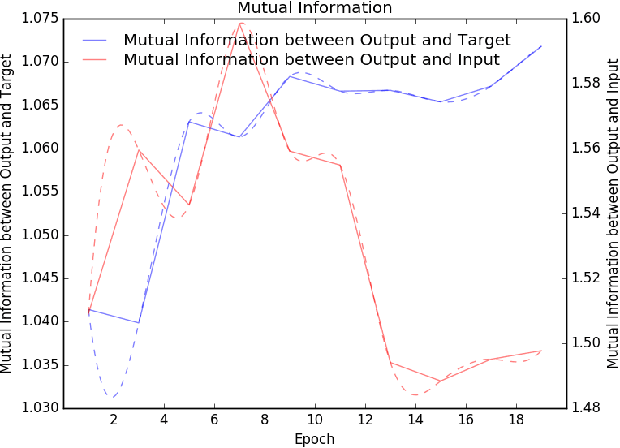
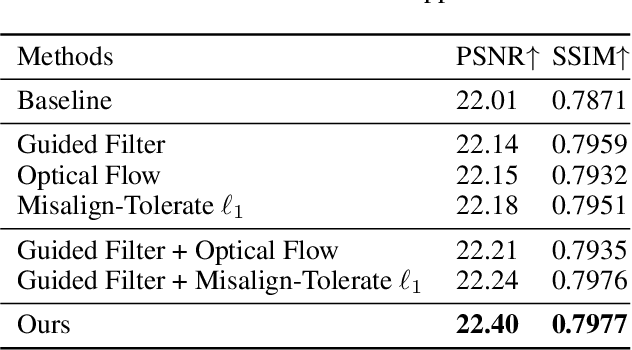
Abstract:Real-world image de-weathering aims at removing various undesirable weather-related artifacts. Owing to the impossibility of capturing image pairs concurrently, existing real-world de-weathering datasets often exhibit inconsistent illumination, position, and textures between the ground-truth images and the input degraded images, resulting in imperfect supervision. Such non-ideal supervision negatively affects the training process of learning-based de-weathering methods. In this work, we attempt to address the problem with a unified solution for various inconsistencies. Specifically, inspired by information bottleneck theory, we first develop a Consistent Label Constructor (CLC) to generate a pseudo-label as consistent as possible with the input degraded image while removing most weather-related degradations. In particular, multiple adjacent frames of the current input are also fed into CLC to enhance the pseudo-label. Then we combine the original imperfect labels and pseudo-labels to jointly supervise the de-weathering model by the proposed Information Allocation Strategy (IAS). During testing, only the de-weathering model is used for inference. Experiments on two real-world de-weathering datasets show that our method helps existing de-weathering models achieve better performance. Codes are available at https://github.com/1180300419/imperfect-deweathering.
 Add to Chrome
Add to Chrome Add to Firefox
Add to Firefox Add to Edge
Add to Edge